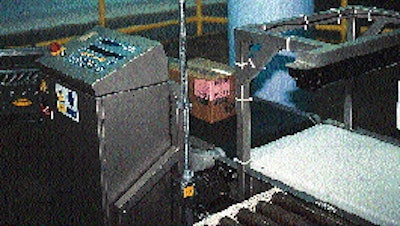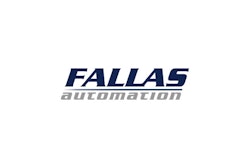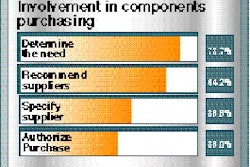This year, Line E-12 at Brach & Brock Confections' sprawling Chicago plant will bag nearly five million lb of chocolate-coated peanut clusters and chocolate stars. Until August, operators packed 12 bags into a corrugated case. Now, however, a robotic pick-and-place machine performs the job, enabling the company to save $150ꯠ/yr in labor costs attributable to the line. The JR-VAC-CE top-load robotic pick-and-place case packer is supplied by Fallas Automation (Waco, TX). According to Fallas, Brach & Brock is the first commercial user of the newest version of the machine, which was recently upgraded to handle more complex packing configurations. Brach & Brock's Chicago plant uses nine Fallas robotic machines, with four more on order. At the company's Chattanooga, TN, headquarters plant, four additional Fallas units are either operating or about to be installed. All of these machines are substitutes for manual case packing. Corporate-wide, this automation should yield substantial labor savings. Charles Fox, the company's director of corporate engineering, anticipates a two-year payback for each machine. Pick-and-place needed "We began using Fallas equipment at our plant about 12 years ago," explains Brian Gramberg, engineering manager at the Chicago plant. "Originally, we bought a drop packer from them. But we were looking for pick-and-place units for our fragile product, so we tried machinery from another supplier that we weren't completely satisfied with. After Fallas developed pick-and-place case packers, we began adding them at our Chicago plant." That was in late '94. The 2.2 million sq' Chicago plant produces hundreds of candy stockkeeping units, packaging them on 66 lines. On Line E-12, the robotic packer is used for 7- and 12-oz bags of chocolate-covered peanut clusters, as well as 7-, 14- and 15.4-oz bags of chocolate stars. Once candy is made, it proceeds through a cooling tunnel before riding an incline conveyor to the net-weigh scales of a vertical form/fill/seal machine that's been running since the mid-'80s. Fill speeds range from 55 to 65 bags/min, depending on bag size. The rollstock material used to form bags is supplied by Printpack (Atlanta, GA) and Duralam (Appleton, WI). From the outside-in, the structure includes 75-ga oriented polypropylene reverse-printed flexographically in four or more colors depending on bag design. The OPP is adhesive-laminated to a 1.75-mil layer of white linear low-density polyethylene. Individual bags discharge from the bottom of the vf/f/s machine, then incline about 10' on a conveyor through a metal detector. Bags make a 90° turn onto the infeed conveyor of the Fallas case packer. Robotic sequence On the infeed, bags convey single-file past a high-speed staging section of the conveyor belt. As bags move across this section, they're grouped in three because Brach & Brock packs these candies three bags/layer, four layers/case. Servo motors speed and slow incoming bags to create a time gap between the last bag of the leading group of three bags and the first bag of the next group of three. This spacing allows more time for the downstream robotic arm to perform its functions. The three bags release from this section one at a time onto a positioning belt. When the third bag reaches the positioning belt and the three bags are side-by-side, a photoeye sensor signals an Allen-Bradley (Milwaukee, WI) programmable logic controller. The PLC/5 then signals the robotic head to move from its home position to grab the group of three bags on the positioning belt. The approximately 10" L x 5" W robotic pick head is connected to an adjustable vacuum tube. This flexible tube is adjustable to varying product heights. At the end opposite the robotic head, the tube connects to the unit's pick-and-place arm. The robotic head pulls complete vacuum of 29.9" of mercury to draw the three bags. The PLC signals servo motors that move the arm to the bags on the positioning belt, delivering them into a corrugated case below. The arm repeats the process four times, so that each case has four layers of three bags. Unlike many robotic systems, which move with a stiff, intermittent motion, this system makes a smooth arc. It curves into the box, wasting no motion. Corrugated case blanks are held within an adjustable magazine. By loosening a few handles and readjusting length and width settings, line operators can adjust the magazine without tools for different case sizes. Brach & Brock packs the five SKUs on E-12 in either 200#- or 250#-test, C-flute corrugated cases from several suppliers. Knocked-down case sizes range from 8" x 13" x 61/2" to 10" x 12" x 9". Cases are erected as two large suction cups pull open the blank from the magazine. The erected case is moved to a load station on an I-beam. As the case contacts the I-beam, the minor bottom flaps are closed by air-actuated cylinders. The majors are plowed shut by a set of plows just under the I-beam. The robotic head loads four layers of three bags into the case as it rests on this I-beam. Once filled with 12 bags, the case discharges along a conveyor past an integrated top-flap closing unit that plows minor flaps inward. Cases convey past a U-shaped bend in the line where top flaps are plowed in by a top-and-bottom case taper. The taped case then passes over a 6000 Series checkweigher from Loma Intl. (Elk Grove Village, IL). Added at the same time as the Fallas robotic pick-and-place case packer, the checkweigher is used to verify bag counts by weight. One bag too many or one too few will cause that case to be rejected automatically. Before the checkweigher was added, line operators made a quick visual count of the manually packed bags before boxes were closed. The combination of robotic case packing and automatic checkweighing provides more consistent accuracy. Next, operators apply a pressure-sensitive label to each case. Stock number, number of units per case, product name, pallet load, stacking pattern and code date are all listed on the label. Cases are hand-stacked onto pallets, then fork-lifted to a shipping room for truck or rail distribution, with nearly all shipments to retailers within the U.S. "We appreciate the robotic case packers because they're so easy to set up and operate," says Bill Osterman, line manager. "We also like the fact that we can change the machine for different bag sizes in less than 30 minutes," adds cell manager Tom Hilton. After tallying labor savings and payback period afforded by the Fallas case packers, Brach & Brock Confections is pleased with the investment. The real proof of that may well be in the orders it has placed for additional packers to serve other lines at its Chicago and Chattanooga plants.






























